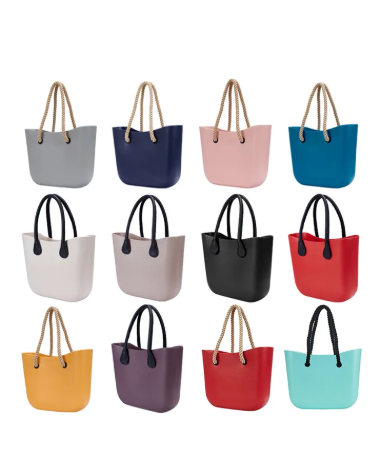Understanding Beach Tote Bag Materials
Cotton Canvas vs. Synthetic Fabrics
Picking out a beach tote bag means knowing what goes into making them, especially when comparing cotton canvas against synthetic stuff. Cotton canvas bags tend to hold up much better over time because of how tightly woven they are. People who have owned both types usually notice this difference after just a few trips to the shore. Synthetic materials do keep things drier since they resist water pretty well, but cotton canvas lets air through which makes carrying stuff more comfortable even if it does soak up some moisture. Plus, cotton breaks down naturally in the environment whereas most synthetics stick around forever. Cotton canvas also looks great with its rough, earthy texture that works with all sorts of beachwear styles. Synthetics come in brighter colors and patterns too, appealing to folks who want something eye-catching for days at the pool or ocean. Ultimately, deciding comes down to what matters most during beach outings whether it's staying dry, looking good, or simply getting value from a bag that lasts season after season.
EVA Plastic Totes: Special Considerations
EVA plastic, or Ethylene Vinyl Acetate, is becoming really popular for beach totes because of how well it performs. What makes this material special? It bends without breaking, lasts through rough handling, and can actually be recycled after use. Recent market trends show people are gravitating toward EVA products more and more thanks to these qualities. But there are some things worth knowing before buying one. Extreme heat or cold can affect EVA's performance, and if dropped from height onto hard surfaces, it might crack or tear. Most folks who have used them swear by EVA for days at the beach where they need something tough enough to handle wet sand and saltwater. For families planning picnics though, they often prefer models that clean up easily when kids spill juice or snacks all over them. Matching what the tote offers with what actual beach day needs will ensure satisfaction with the purchase.
Identifying Lining and Hardware Types
What's inside matters just as much as what's on the outside when it comes to beach totes. The right lining makes all the difference for keeping stuff dry and protected from heat. Most good totes have waterproof polyester linings that actually work against sand and water damage. Then there's the hardware everyone tends to overlook but really matters. Zippers get stuck after a few trips to the shore, and cheap clasps just fall apart when exposed to saltwater. Smart shoppers know to look closely at three things before buying: Is the lining thick enough to block moisture? Do the zippers glide open and shut without sticking? And are those seams stitched properly so they won't come undone after carrying heavy wet towels? A quick inspection can save headaches later on. After all, nobody wants their sunscreen melting into soggy snacks during a day at the beach.
Daily Maintenance Essentials
Shaking Out Sand and Debris
Shaking sand and grit out of that beach tote after each trip makes all the difference in how long it lasts and looks good. Those tiny grains actually wear away at the material over time, making holes and dulling colors. Most folks do this right there on the sand or find a spot away from where others are sitting to clean up properly. Before giving it a good shake though, double check that nothing valuable is still inside since vigorous movements can send stuff flying. Taking these few minutes for maintenance keeps the bag looking fresh season after season, so it stays ready for whatever summer adventure comes next.
Quick-Wipe Techniques for Spills
Quick wipe techniques work well for getting rid of spills and stains on beach tote bags. Grab a microfiber cloth or soft sponge right away when something gets spilled to stop stains from setting in. Getting to spills fast keeps the bag looking good and stops permanent damage to the fabric that happens when messes sit too long. Canvas tends to soak up liquid pretty quickly, so grabbing a cloth ASAP makes all the difference in keeping the tote looking fresh and lasting longer through summer season after summer season.
Avoiding Overloading and Stress Points
Putting too much stuff into a beach tote will eventually cause problems with the stitching and general structure, which usually means the bag gives out sooner than expected. People who carry way more than what their tote was designed for tend to find themselves dealing with broken straps or torn fabric after just one trip to the shore. Stick to what manufacturers recommend regarding how heavy the load should be, depending on whether it's made from cotton canvas or some kind of plastic material. Look at where most of the pressure builds up inside the bag and spread things around evenly so nothing gets overstressed. Before heading out next time, take a quick peek at those seams running along the sides and make sure none look stretched out or weak. A little maintenance goes a long way toward keeping that favorite beach companion looking good while still doing its job carrying all our stuff down to the sand.
Deep Cleaning Methods
Hand-Washing Cotton Canvas Totes
When washing cotton canvas totes by hand, taking things slow really helps keep the fabric looking good over time. Start with some warm (not hot) water mixed with a mild detergent made for cotton materials. Companies such as Dongguan Shengteng suggest trying products like Woolite or Ecover since they tend to be gentler on these types of fabrics. Let the bag sit in soapy water for around ten minutes first, then give it a gentle massage rather than aggressive scrubbing. Make sure to rinse out all the soap completely. Never twist or squeeze the wet fabric because that can actually break down the fibers. The best way to dry is simply hanging it somewhere indoors where there's no direct sun exposure. This helps maintain both the colors and the overall feel of the material for longer periods between washes.
Disinfecting EVA Plastic Surfaces
Keeping EVA plastic surfaces clean matters a lot for hygiene while still protecting what makes them good quality stuff. For disinfecting, folks usually go with either mild soap mixed into water or something like isopropyl alcohol works just fine too since they don't damage EVA plastics much. The folks at Dongguan Shengteng recommend giving these surfaces a good wipe down once a week especially when they see heavy use across different settings. Nobody wants their nice looking surface ruined so take it easy on the scrubbing part to avoid any nasty scratches that can really mess up how it looks over time.
When to Use Mild Detergents
Using gentle soaps makes all the difference when it comes to keeping beach totes looking good for years. Brands like Tide Free & Gentle or Seventh Generation work wonders because they're formulated to be kind to fabrics while still getting rid of sand and saltwater stains. We've noticed at Dongguan Shengteng that people tend to wait until their bags start showing real wear before giving them a proper clean. A quick wash once a month usually does the trick though, just enough to freshen things up without damaging the material. The big no-no? Harsh chemicals that eat away at colors and eventually make the fabric brittle. Stick with those mild options and watch how much longer your favorite tote lasts through summer after summer.
Drying and Storage Solutions
Proper Air-Drying Techniques
Letting beach tote bags air dry really helps keep them in good shape and hygienic condition. Most health experts point out that when bags get properly dried, they avoid those pesky molds and mildews that love damp spots. The best way to go about this? Find someplace with decent airflow for hanging them, but steer clear of direct sun exposure since UV rays will eventually dull colors and weaken fabric quality. Getting the right drying location makes all the difference, protecting both the material itself and giving these bags longer useful lives overall.
Folding vs. Hanging Strategies
How we store our beach totes matters a lot when it comes to how long they'll last. When we hang them instead of folding, the bags keep their shape better and don't get those annoying creases, especially good for sturdier totes. But let's face it, sometimes there just isn't enough room on the wall for all those hanging bags. That's where folding becomes handy, though we should be careful not to squish them too tight otherwise the fabric gets damaged and those pesky wrinkles show up again. Take stock of what kind of space we have available and how many totes need storing before picking the method that works best for our situation.
Moisture Control in Storage Areas
Beach totes don't handle moisture and humidity well at all. Left in damp conditions, they tend to develop mold spots and the fabrics just break down faster than normal. The best way around this problem? Control where they're stored. Silica gel packs work pretty good for soaking up extra dampness, or some folks swear by activated charcoal for the same purpose. These little tricks help keep things dry enough so the tote bags stay in better shape longer. Just don't forget to swap out those moisture absorbing packets every now and then when they start getting saturated. Nobody wants to find their favorite beach bag ruined because nobody bothered to replace the old drying agent.
Troubleshooting Common Issues
Removing Saltwater Stains
Those pesky saltwater stains on beach totes really stick around sometimes, but there's something that actually works after trying several methods myself. The key is to get fresh water on the spot right away before things get worse. Grab some mild soap, mix it with water, and dab it onto the stained area. A gentle scrub with an old toothbrush does wonders here. Let it soak for maybe 15 mins then give it a good rinse under cold tap water. From what I've seen over time, acting fast and using basic soap tends to do the trick most of the time. Want to keep this from happening again? Invest in those waterproof covers they sell at outdoor stores. Trust me, it saves so much hassle later when heading back home from another day at the shore.
Eliminating Musty Odors
When dealing with those annoying musty smells, there are actually some pretty straightforward fixes right at home. Baking soda works wonders for this stuff. Just sprinkle some inside whatever container has the bad smell and leave it alone for a night or two. The baking soda will soak up all those nasty odors. If that doesn't do the trick, try wiping down surfaces with something acidic like white vinegar or fresh lemon juice. A cloth dipped in either of these solutions can really cut through stubborn smells. Something I learned from experience is making sure everything gets aired out properly. Let items dry completely before putting them away somewhere dark and closed off. Moisture builds up over time and creates breeding grounds for those unpleasant smells we all hate so much. Keeping things dry isn't just good practice, it's practically essential if we want to avoid having to deal with these problems again later on.
Preventing Color Bleeding
Beach tote bags tend to suffer from color bleeding problems quite frequently, particularly those with bold colors or intricate patterns. Hot water definitely contributes to this issue most of the time. Fabrics such as cotton and polyester get especially affected when heated up during laundry cycles. For keeping colors looking good, many folks recommend going with cold water washes and grabbing some gentle detergent labeled safe for colors. When dealing with printed totes, flipping them inside out before tossing into the washer helps cut down on fabric rubbing against each other. Following these simple steps keeps those eye catching designs looking fresh much longer than they otherwise would.
By addressing these common issues, beach tote bags can be kept not only clean but in optimal condition, ready for continued use while maintaining their original charm.
FAQ
What are the advantages of cotton canvas beach tote bags?
Cotton canvas beach tote bags are known for their durability, eco-friendliness, breathability, and rustic aesthetic appeal compared to synthetic fabrics.
Why is EVA plastic a popular material for beach totes?
EVA plastic is favored for its flexibility, durability, and recyclability, making it suitable for various beach activities.
How can I maintain the condition of my beach tote bag?
Regularly shake out debris, use quick-wipe techniques for spills, avoid overloading, and follow specific cleaning methods to preserve its appearance and functionality.
Why should I choose mild detergents for cleaning?
Mild detergents prevent the degradation of fabric fibers and maintain the softness and colors of the bag.
How can I prevent moisture damage during storage?
Control moisture by using silica gel packets and activated charcoal to absorb excess humidity in storage areas.







